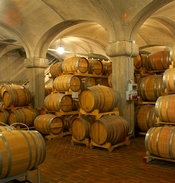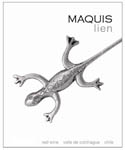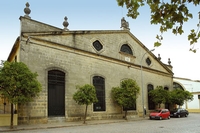Winery of the Year: Terredora Dipaolo
My criteria for selecting a winery of the year are pretty straightforward–if rather numerous: The wines need to be delicious, fairly-priced, food-friendly, reasonably widely-available, consistent across the entire line of products, true to their place of origin, respectful of local grape traditions, and marked by a distinctiveness of character and style.
traditions, and marked by a distinctiveness of character and style.
That’s a lot to ask of a winery, and only a few manage to answer the call in any given year. Nevertheless, there are always a few rather than just one. So, to select an ultimate winner, I rely on another, rather less tangible criterion: Coherent complexity.
If you don’t immediately know what I mean by this, you can taste what it means by trying a wine from my top winery for 2009, Terradora Dipaolo from Campania in southern Italy.  Terradora produces an entire line of wines that stand as object lessons in coherent complexity. Whether white or red, the current releases are intricate and nuanced, with multiple aromas, flavors and textural elements. At the same time, all of these distinct sensory signals are symmetrical in their prominence relative to one another, producing an overall experience of a coherent whole that is greater than the sum of its parts.
Terradora produces an entire line of wines that stand as object lessons in coherent complexity. Whether white or red, the current releases are intricate and nuanced, with multiple aromas, flavors and textural elements. At the same time, all of these distinct sensory signals are symmetrical in their prominence relative to one another, producing an overall experience of a coherent whole that is greater than the sum of its parts.
Terradora’s reds are terrific and the whites are arguably even better (as a group, I thought them the best Biancos I tasted from anyone in Italy in 2009). Three white wines to look for are 2008 vintage Falanghina ($18), Greco di Tufo ($25) and Fiano di Avellino ($29). Ttwo excellent reds are 2008 Campania IGT Aglianico and 2003 Taurasi. These aren’t cheap, but they offer very good value for the money, and are fairly widely available through Vias Imports. With these wines, tasting is believing–instantly.
With economic conditions still so fragile around the world, I want to recognize two wines this year, one priced under $20 and one without regard to cost.
Maquis, Colchagua Valley (Chile) “Lien” 2006 ($19, Global Vineyard Importers): Chile has demonstrated its ability to produce a few amazing high-end wines. It is also a reliable source for many good bottlings at affordable prices. However, the key to Chile’s future success will lie in making truly excellent wines at moderate price points, and this wine is an almost perfect embodiment of that aspiration. A blend of 42% Syrah, 30% Carmenère, 12% Cabernet Franc, 9% Petit Verdot and 7% Malbec, it is a phenomenal over-achiever showing the complexity, texture and overall class of a much more expensive wine. I’ve tasted it three times during the year and came away more impressed in each instance. The last time around, I kept the bottle open for three days, and the wine showed nothing but improvement over that span, which defies belief for a wine priced under $20. Wonderful now with food, it is likely to develop (i.e., not just last, but actually improve) for up to a decade. Ricardo Rivadeneira Hurtado and his French consultant, Xavier Choné are achieving something important in the Colchagua Valley, and you’d be wise to taste it while it is still such a bargain.
future success will lie in making truly excellent wines at moderate price points, and this wine is an almost perfect embodiment of that aspiration. A blend of 42% Syrah, 30% Carmenère, 12% Cabernet Franc, 9% Petit Verdot and 7% Malbec, it is a phenomenal over-achiever showing the complexity, texture and overall class of a much more expensive wine. I’ve tasted it three times during the year and came away more impressed in each instance. The last time around, I kept the bottle open for three days, and the wine showed nothing but improvement over that span, which defies belief for a wine priced under $20. Wonderful now with food, it is likely to develop (i.e., not just last, but actually improve) for up to a decade. Ricardo Rivadeneira Hurtado and his French consultant, Xavier Choné are achieving something important in the Colchagua Valley, and you’d be wise to taste it while it is still such a bargain.
Bodegas Dios Baco, Oloroso Sherry “Baco Imperial” 30 Year-Old NV ($100, CIV USA): Sherry isn’t the easiest wine to sell at any price,  and I admit that I wouldn’t want to have to pay the rent by selling $100 bottles of it. Nevertheless, this was probably the single best wine that I’ve tasted in 2009. It is phenomenally intricate and yet perfectly balanced. The aromas, palate flavors and finish are all intensely expressive, but the wine is so finely integrated after 30 years of maturation that there’s a symphonic impression to it, and the “orchestra” was having an extremely good night on each of the three nights when I evaluated it. Rich, concentrated and very deeply flavored, it is nevertheless dry and brilliantly infused with fresh acidity that keeps the wine from ever seeming heavy or ponderous. Each sip delivers a welter of rich, intense flavors, with notes that tail off very slowly and in perfect symmetry, so that the ensemble of flavors is decreasingly intense but essentially identical for a full 30 seconds after the wine has been swallowed. If you want to exchange some holiday gift money in return for a riveting wine experience, this is the ticket.
and I admit that I wouldn’t want to have to pay the rent by selling $100 bottles of it. Nevertheless, this was probably the single best wine that I’ve tasted in 2009. It is phenomenally intricate and yet perfectly balanced. The aromas, palate flavors and finish are all intensely expressive, but the wine is so finely integrated after 30 years of maturation that there’s a symphonic impression to it, and the “orchestra” was having an extremely good night on each of the three nights when I evaluated it. Rich, concentrated and very deeply flavored, it is nevertheless dry and brilliantly infused with fresh acidity that keeps the wine from ever seeming heavy or ponderous. Each sip delivers a welter of rich, intense flavors, with notes that tail off very slowly and in perfect symmetry, so that the ensemble of flavors is decreasingly intense but essentially identical for a full 30 seconds after the wine has been swallowed. If you want to exchange some holiday gift money in return for a riveting wine experience, this is the ticket.
1
